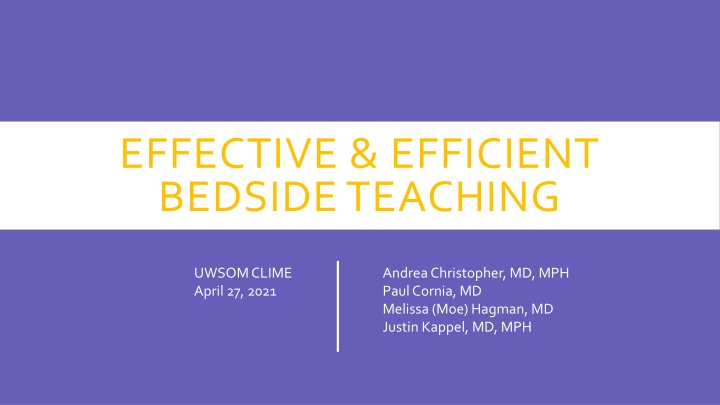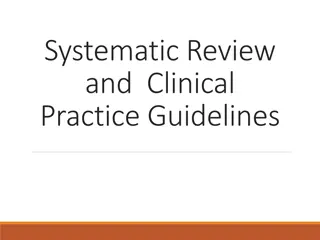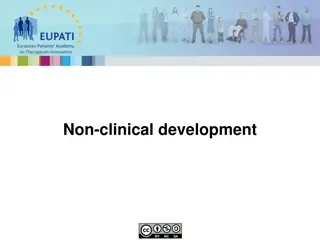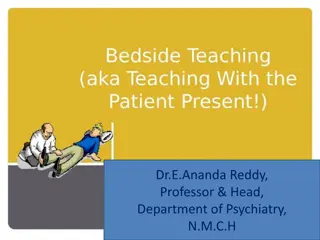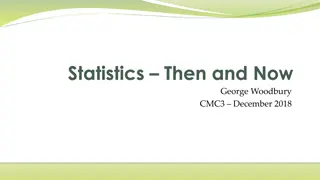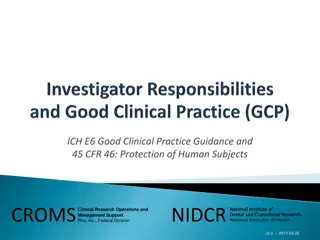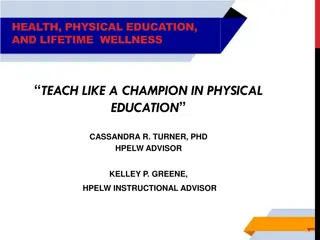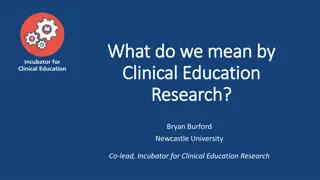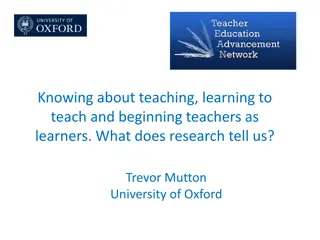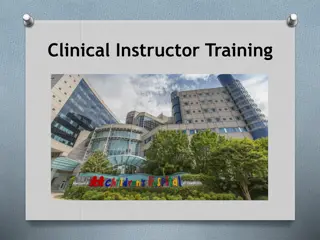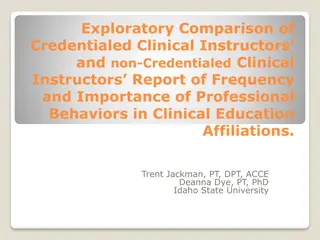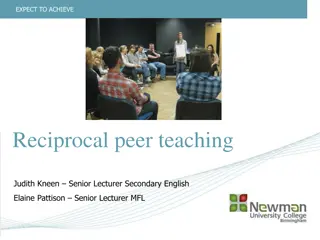Enhancing Bedside Teaching in Clinical Practice: Strategies and Challenges
Explore the importance of effective bedside teaching in clinical settings with a focus on maintaining patient and learner-centeredness. Dive into strategies, historical context, challenges, and tools for improving bedside teaching, addressing issues like time constraints and privacy concerns during the COVID-19 pandemic.
Download Presentation

Please find below an Image/Link to download the presentation.
The content on the website is provided AS IS for your information and personal use only. It may not be sold, licensed, or shared on other websites without obtaining consent from the author.If you encounter any issues during the download, it is possible that the publisher has removed the file from their server.
You are allowed to download the files provided on this website for personal or commercial use, subject to the condition that they are used lawfully. All files are the property of their respective owners.
The content on the website is provided AS IS for your information and personal use only. It may not be sold, licensed, or shared on other websites without obtaining consent from the author.
E N D
Presentation Transcript
EFFECTIVE & EFFICIENT BEDSIDE TEACHING UWSOM CLIME April 27, 2021 Andrea Christopher, MD, MPH Paul Cornia, MD Melissa (Moe) Hagman, MD Justin Kappel, MD, MPH
INTRODUCTIONS Speaker intros Visual audience intros: Turn your camera on if the prompt fits you. Geographic location Clinical practice setting Learners
DISCLOSURES No financial conflicts to disclose
GUIDELINES FOR DISCUSSION All of you is welcome here If you are able, please turn on video We welcome participation through the chat & unmuting to speak If we get zoom bombed, we will turn off cameras and chat Assume positive intent & turn to wonder Step up / Step back
1. Teach clinical reasoning at the bedside OBJECTIVES 2. Maintain patient AND learner centeredness 3. Complete teaching and clinical tasks in the time allotted
AGENDA Why teach at the bedside When, where and how to teach at the bedside Strategies for effective and efficient bedside teaching Tools and language to improve your bedside teaching
HISTORY OF BEDSIDE TEACHING Bedside teaching was previously the norm, what happened? Medical technology, EMR, expanded documentation requirements Resident duty hour restrictions Absence of role models and experienced facilitators Joyce Wipf, MD Jan Hirschmann, MD Steven McGee, MD Erika Goldstein, MD, MPH Reichsman F, et al. J Med Educ, 39. 147-63. Fihn s, et al. 2000. J Gen Intern Med, 15, 451-6.
CHALLENGES WITH BEDSIDE TEACHING Limits to time Thin ice syndrome Space and privacy for patients During the COVID19 pandemic: exposure risk, limited available PPE No data showing improved patient outcomes Ramani S, et al. Acad Med, 78, 384-90. Wang-Cheng, et al. J Gen Intern Med, 4. 284-7.
BENEFITS OF BEDSIDE TEACHING Opportunity to give feedback: Communication with patient Skills such as physical exam, patient education Role modeling with the patient Engage the patient in decision making Make time spent on patient care transparent to patients and their loved ones
Introduce yourselves Why are you here today? What do you hope SMALL GROUP #1 to learn? Reflect on / share any notable stories where (15 MIN) bedside teaching went well or poorly. What has been challenging for you when doing bedside teaching?
WHEN/WHERE/HOW TO TEACH AT THE BEDSIDE
ROUNDING VS TEACHING Rounding: Review clinical data Develop plan of care Inform the patient and healthcare team Teaching: Expand learner s clinical knowledge Develop information gathering skills and medical decision making Test learner in real-world scenario in order to give formative feedback
ROUNDING VS TEACHING Lessons from Rhetoric : the capacities of writers or speakers needed to inform, persuade, or motivate particular audiences in specific situations
ROUNDING VS TEACHING Rounding -> bedside rounding -> bedside teaching Adding more audiences Adding complexity and competing needs Blurring the specific context and goals of the clinical situation Testing the myth of multi-tasking
GETTING THE MOST OUT OF BEDSIDE TEACHING Communicate, communicate, communicate! Flexibility Creativity Practice
STRATEGIES FOR EFFECTIVE AND EFFICIENT BEDSIDE TEACHING
PREPARE THE TEAM Team meeting before 1st rounding session Get to know each other People don't care how much you know until they know how much you care , Theodore Roosevelt Get buy-in Explain the why Define bedside roles Attending, resident, intern, medical student Oral presentations (1) McGee S. JAMA. 2014;311(19):1971-1972.
PREPARE YOURSELF Review charts Develop high yield teaching scripts, exam maneuvers, etc. Role model Real time clinical reasoning Acknowledge uncertainty, discuss how you deal with it (eg, discuss with colleagues/specialists, lit review, etc)
PREPARE THE PATIENT Ask permission Ensure patient comfort Verghese What are the two most important buttons in medicine? Not the left and right mouse button. The light switch and the button that raises the bed. Introduce team members Acknowledge family members, loved ones, etc. that are present
SMALL GROUP #2 Case #1 Just a rash (15 MIN)
TOOLS AND LANGUAGE TO IMPROVE YOUR BEDSIDE TEACHING
TEACH LIKE A CHAMPION Create an Effective Learning Environment J Factor Normalize Error Wait Time
TEACH LIKE A CHAMPION Engage the Learner Ratio The Hook Take a Stand
TEACH LIKE A CHAMPION Set High Academic Expectations Stretch It Right Is Right Break It Down No Opt Out Format Matters
SMALL GROUP #3 Case #2 A Most Helpful Patient (15 MIN)
1. Teach clinical reasoning at the bedside OBJECTIVES 2. Maintain patient AND learner centeredness 3. Complete teaching and clinical tasks in the time allotted
IN CONCLUSION Prepare yourself Communicate Prepare the team Be flexible Prepare the patient Get creative
IN CONCLUSION Practice, practice, practice!
THANK YOU! Special thanks to Dr. Jessica Lu and Dr. Alex Chen of the UW Family Medicine Residency as well as the VA Boise Simulation Lab: Brian Cruthirds Tara Nyborg Jenn Snyder Lydia Carbis (Idaho WWAMI)
THANK YOU! Please reach out with questions/feedback: Moe Hagman (mhagman@uw.edu) Justin Kappel (kappeljd@uw.edu) Andrea Christopher (andrea.christopher@va.gov) Paul Cornia (paul.cornia@va.gov)
